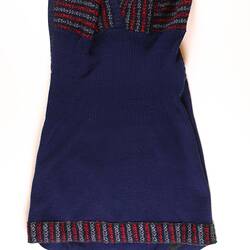Summary
Yarn Feeder used with 'Dubied' knitting machine, used by Edda Azzola from 1950 to 2000 for making commercial and personal clothing. This 'Dubied' knitting machine was brought to Australia from Italy in the 1950s by an Italian migrant woman and then sold to the Edda, who had migrated to Melbourne from Italy in 1955. Edda used it to supply a Collingwood knitting mill with finely finished clothes for sale to Melbourne department stores, until the factory closed in 1974. It was then used to make family clothes.
The machine is in similar condition as when first purchased by Edda, except for two modifications made by her husband: wooden blocks under the cast iron frame to raise its height so that she was relieved from constant bending over; and the removal of a flexible arm which moved as the carriage was shunted across - one day nearly clamping her son's leg! So for safety reasons, he made a new two-handed carriage which she also found much easier to use while standing to operate the machine.
Physical Description
An arrow head shaped piece of metal attached to a longer stem, with a small hole in the tip of the arrow head, for guiding yarn. The arm has one hole for a screw attachment, and four small raised ridges on the back.
Significance
The Edda Azzola knitting machine collection enables the exploration of issues relating to post World War II migration experiences, outworker working life, the post-war inner city Melbourne textile industry and dowry production. The collection, which includes a domestic knitting machine, tools, materials, textile samples, garments, a design notebook, photographs, an oral history interview, operator demonstration video and hand made glory box items, all combine to create a rich snapshot of working and migrant life, particularly significant with the large numbers of migrant women who were employed in and for textile factories around the city. This story and collection is also enriched by its close connection to the Richard Charlupksi story, for whom Edda worked and which explores the 1950s-1970s wool fashion industry.
More Information
-
Collecting Areas
-
Acquisition Information
Donation from Mrs Edda Azzola, 17 Dec 2007
-
Manufacturer
-
User
Mrs Edda Azzola, Fitzroy North, Greater Melbourne, Victoria, Australia, 1958-1960
-
User
Mrs Edda Azzola, Reservoir, Greater Melbourne, Victoria, Australia, 1960-2000
-
Inscriptions
Stamped on back: '327'.
-
Classification
-
Category
-
Discipline
-
Type of item
-
Object Measurements
40 mm (Length), 15 mm (Width), 7 mm (Height)
-
Keywords
Clothing Trade, Immigration, Italian Communities, Italian Immigration, Textile Industry


